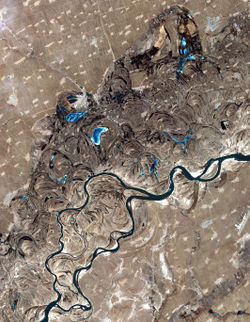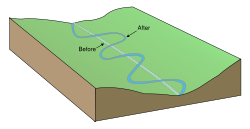Meander
2007 Schools Wikipedia Selection. Related subjects: Geology and geophysics
A meander is a bend in a river, also known as an oxbow loop. A stream or river flowing through a wide valley or flat plain will tend to form a meandering stream course as it alternatively erodes and deposits sediments along its course. The result is a snaking pattern as the stream meanders back and forth across its floodplain. When a meander gets cut off from the main stream body, an oxbow lake is formed.
A meander is formed because the river flows faster on the outside edge of any small curve and slower along the inside edge. Deposition of sediment occurs on the inner edge because the river, moving slowly, cannot carry its sediment load, creating a slip-off slope. The faster moving current on the outside bend has more erosive ability and the meander tends to grow in the direction of the outside bend, forming a river cliff. This can be seen in areas where willows grow on the banks of rivers; on the inside of meanders, willows are often far from the bank, whilst on the outside of the bend, the roots of the willows are often exposed and undercut, eventually leading the trees to fall into the river. This demonstrates the river's movement.

If the region later undergoes tectonic uplift, the meandering stream will again resume downward erosion. The meandering pattern will remain as a deep valley known as an incised meander. Rivers in the Colorado Plateau and streams in the Ozark Plateau are noted for these incised meanders.
Sometimes an incised, also known as entrenched, meander is cut off. When it is, the resulting landform is called a rincon. They are created when a river erodes through the narrow neck of land between the ends of a loop, leaving the loop without an active cutting stream. One dramatic rincon on Lake Powell is called "The Rincon."
Origin of term
The term derives from the Maeander River in Turkey, characterised by a very convoluted path. As such, early usage of the term, from the late 1500s, referred to convoluted and windy speech and ideas, as well as the geomorphological feature. The river in Turkey is called Menderes River, south of Izmir, near the ancient Greek town of Miletos.
Meander ratio
Meander ratio is a means of quantifying how much a river or stream meanders (how much its course deviates from the shortest possible path). It is calculated as the length of the stream divided by the length of the valley. A perfectly straight river would have a meander ratio of 1 (it would be the same length as its valley), while the higher this ratio is above 1, the more the river meanders.

